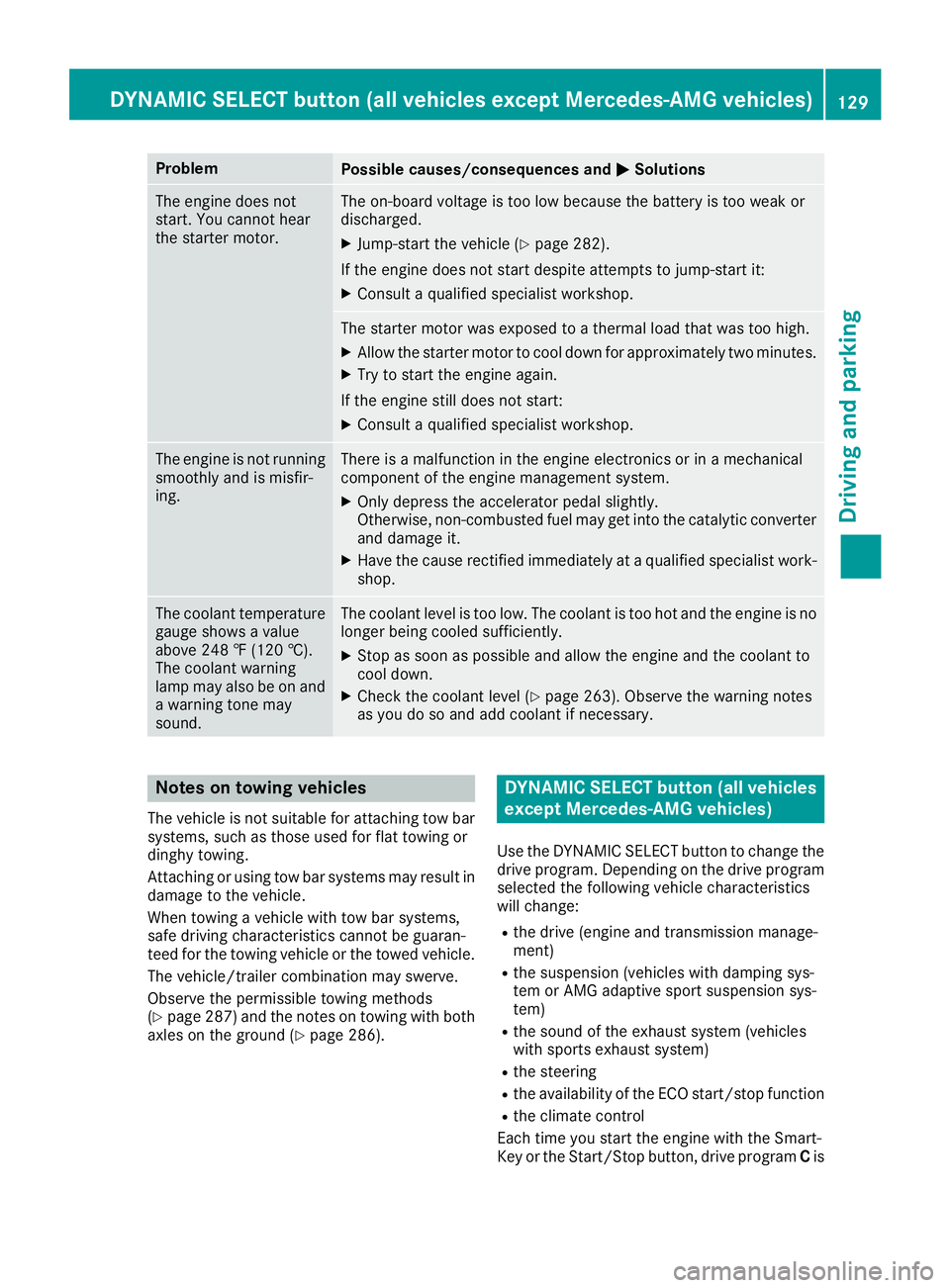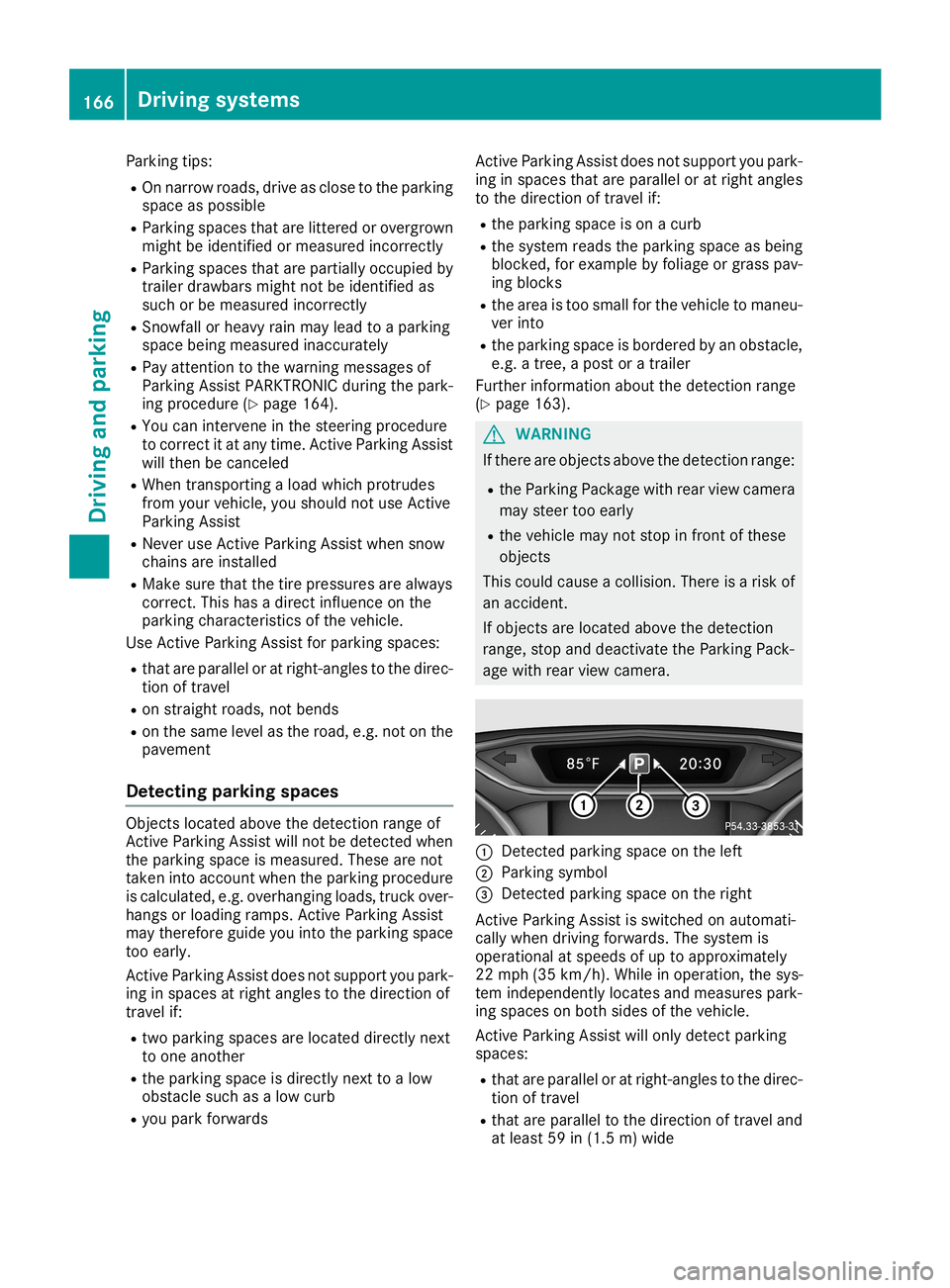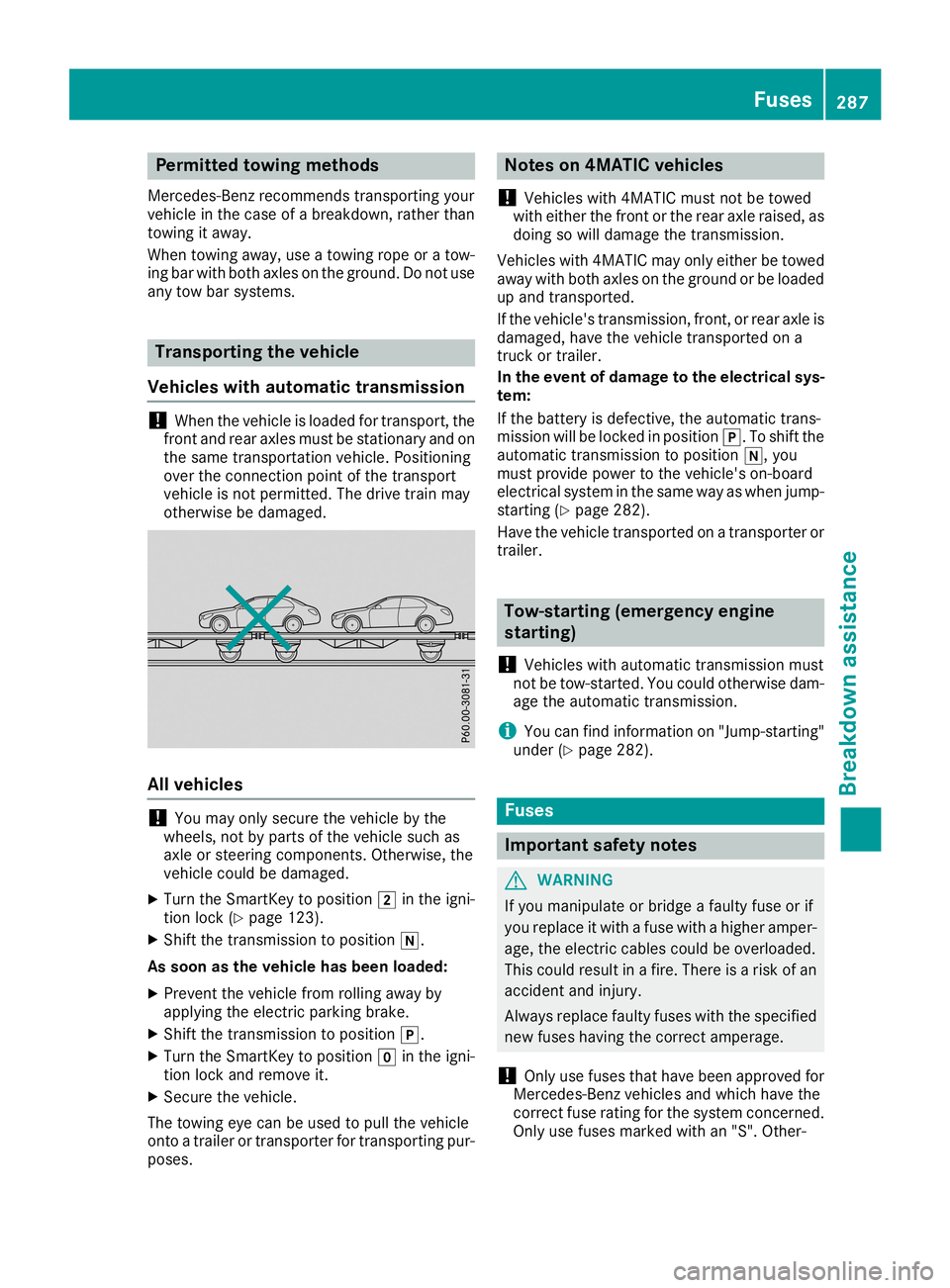2019 MERCEDES-BENZ CLA COUPE trailer
[x] Cancel search: trailerPage 131 of 330

Problem
Possible
causes/co nsequences and0050 0050
Solutions The
engine doesnot
start. Youcannot hear
the starter motor. The
on-board voltageistoo low because thebattery istoo weak or
discharged.
X Jump-start thevehicle (Ypage 282).
If the engine doesnotstart despite attemptsto jump-st artit:
X Consult aquali fiedspecialist workshop. The
starter motorwasexposed toathermal loadthatwastoohigh.
X Allow thestarter motortocool down forapproximately twominutes.
X Try tostart theengine again.
If the engine stilldoes notstart:
X Consult aquali fiedspecialist workshop. The
engine isnot running
smoothly andismisfir-
ing. There
isamalfunction inthe engine electron icsorinamechanical
componen tof the engine management system.
X Only depress theaccelerator pedalslightly.
Otherwise, non-combusted fuelmay getinto thecatalytic converter
and damage it.
X Have thecause rectified immediately ataqual ified specialist work-
shop. The
coolant temperature
gauge shows avalue
above 248‡(120 †).
The coolant warning
lamp mayalsobeon and
a warning tonemay
sound. The
coolant levelistoo low. Thecoolant istoo hotand theengine isno
longer beingcooled sufficiently.
X Stop assoon aspossible andallow theengine andthecoolant to
cool down.
X Check thecoolant level(Ypage 263). Observe thewarning notes
as you dosoand add coolant ifnecessary. Notes
ontowing vehicles
The vehicle isnot suitable forattaching towbar
systems, suchasthose usedforflat towing or
dinghy towing.
Att aching orusing towbarsystems mayresult in
damage tothe vehicle.
When towing avehicle withtowbarsystems,
safe driving characterist icscannot beguaran-
teed forthe towing vehicle orthe towed vehicle.
The vehicle/trailer combinationmayswerve.
Observe thepermissible towingmethods
(Y page 287)andthenotes ontowing withboth
axles onthe ground (Ypage 286). DYNAMIC
SELECTbutt on(all vehicle s
except Mercedes-AMG vehicles)
Use theDYNAMIC SELECTbutton tochange the
drive program. Depending onthe drive program
selected thefollowing vehiclecharacterist ics
will change:
R the drive (engine andtransmission manage-
ment)
R the suspension (vehicleswithdamping sys-
tem orAMG adaptive sportsuspension sys-
tem)
R the sound ofthe exhaust system(vehicles
with sports exhaust system)
R the steering
R the availa bilityofthe ECO start/ stopfunct ion
R the climate control
Each timeyoustart theengine withtheSmart-
Key orthe Start /Stopbutton, driveprogram Cis DY
NAMIC SELECTbutt on(all vehicl esexce ptMercedes-AMG vehicles)
129Driving andparking Z
Page 168 of 330

Parking
tips:
R On narrow roads,driveasclose tothe parking
space aspossible
R Parking spacesthatarelittered orovergrown
might beidentified ormeasured incorrectly
R Parking spacesthatarepartially occupied by
trailer drawbars mightnotbeidentified as
such orbe measured incorrectly
R Snowf allorheavy rainmay lead toaparking
space beingmeasured inaccurately
R Pay atten tiontothe warning messages of
Parking AssistPARKTRONIC duringthepark-
ing procedure (Ypage 164).
R You caninter vene inthe steerin gprocedure
to correc tit at any time. ActiveParking Assist
will then becanc eled
R When transportin gaload which protrudes
from yourvehicle, youshould notuse Active
Parking Assist
R Never useActive Parking Assistwhensnow
chains areinstalled
R Make surethatthetire pressures arealway s
correc t.This hasadirect influenc eon the
parking characteristics ofthe vehicle.
Use Active Parking Assistforparking spaces:
R that areparallel oratright- angles tothe direc-
tion oftravel
R on straight roads,notbends
R on the same levelasthe road, e.g.notonthe
pavement
Detecting parking spaces Object
slocated abovethedetect ionrange of
Act ive Parking Assistwillnotbedetect edwhen
the parking spaceismeasured. Thesearenot
taken intoaccount whentheparking procedure
is calculated, e.g.overhangin gloads, truckover-
hangs orloading ramps.Active Parking Assist
may theref oreguide youinto theparking space
too early.
Act iveParking Assistdoesnotsupport youpark-
ing inspaces atright angles tothe direction of
travel if:
R two parking spacesarelocated directly next
to one another
R the parking spaceisdirectly nexttoalow
obstacle suchasalow curb
R you park forwards Act
iveParking Assistdoesnotsupport youpark-
ing inspaces thatareparallel oratright angles
to the direction oftravel if:
R the parking spaceison acurb
R the system readstheparking spaceasbeing
blocked, forexample byfoliage orgrass pav-
ing blocks
R the area istoo small forthe vehicle tomaneu-
ver into
R the parking spaceisbordered byan obstacle,
e.g. atree, apost oratrailer
Further informationabout thedetect ionrange
(Y page 163). G
WARNIN
G
If there areobject sabove thedetect ionrange:
R the Parking Package withrearview camera
may steer tooearly
R the vehicle maynotstop infron tof these
object s
This could cause acollision. Thereisarisk of
an accident .
If object sare located abovethedetect ion
range, stopanddeactivate theParking Pack-
age with rearview camera. 0043
Detected parking spaceonthe left
0044 Parking symbol
0087 Detected parking spaceonthe right
Act ive Parking Assistisswitched onautomati-
cally when driving forwards. Thesystem is
operational atspeeds ofup toapproximately
22 mph (35km/ h).Whi lein ope ration, the sys-
tem indepe ndentl ylo cate sand measures park-
ing spaces onboth sides ofthe vehicle.
Active Parking Assistwillonly detectparking
spa ces:
R that areparal lelor atrig ht-ang lesto the direc-
tion oftrav el
R that areparal lelto the directi onoftrav eland
at leas t59 in(1.5 m)wide 16
6 Dri
ving sys temsDriving and parkin g
Page 172 of 330

R
ifthe camer alens isdirt yor obst ructed.
Obser vethe noteson clean ing
(Y page 269)
R ifthe rear ofyour vehic leisdamaged. Inthis
case, havethecamer aposit ionand setting
chec kedataqualified specialist workshop.
The field ofvision andotherfunc tionsof the rear
view camer amay berest ricteddue toaddition al
acc essor iesonthe rear ofthe vehic le(e.g.
licen seplate holder ,rear bicyc lerack ).
i The
contrast ofthe display maybeaffec ted
by the sudden presenceof sunligh tor oth er
light sourc es,e.g. when exitingagarage. Pay
part icular attent ion inthis situat ion.
i If
usability issever elyrest ricted, e.g. due to
pixel errors,have thedisplay repairedor
replac ed.
Activa ting/d eactivating therea rview
cam era X
To acti vate:make surethattheSmar tKey is
in posit ion0048inthe ignit ionlock .
X Make surethattheActi vationbyRgear Acti
vationbyRgear
func tionisselec tedinthe multim ediasystem;
see theDigit alOperat or'sManual.
X En gage reversegear.
The area behin dthe vehic leisshown with
guide linesinthe multim ediasystemdisplay.
The image fromthe rear view camer ais avail-
able throughout themane uverin gproc ess.
To deact ivate:the rear view camer adeact i-
vate sif you shift thetransm ission to005D oraft er
drivin gfor wards ashor tdist ance.
The innersegme ntsof the warnin gindic atorare
displayed inred ifthe reisacom plete system
failure. Theindic atorlamp inthe PARK TRONIC
butt onlight sup.
If the syst emfails atthe rear ofthe vehic le:
R the rear segme ntsare shown inred when
back ingup.
R the rear segme ntsare hidden whendriving
for wards. Messa
gesinthemu ltim edia systemdis-
pla y The
rear view camer amay show adist orted view
of obst acles, showtheminc orre ctly or not atall.
The rear view camer adoes notshow objectsin
the followin gposit ions:
R very closeto the rear bumper
R under therear bumper
R in clos erang eabove thehandle onthe trunk
lid
! Obj
ectsnot atgroun dlevel mayappear to
be furt her away thantheyact ually are,e.g.:
R the bumper ofapark edvehic le
R the drawbar ofatrailer
R the ball couplin gof atrailer towhitch
R the rear sectionofan HGV
R aslant edpost
Use theguideline sonly fororien tation.
Appr oach objectsno furt her than thebott om-
most guideline . 0043
Yellow guidelineatadist anceof approx -
imate ly13 ft(4. 0m) fromthe rear ofthe
vehic le
0044 Whit eguide linewitho utste erin ginput –
vehic lewidth including theexterior mirrors
(st atic )
0087 Yellow guidelineforthe vehic lewidth
inc luding theexterior mirrors, atthe curr ent
ste erin gwheel angle(dynamic )
0085 Yellow lanemark ingthe cour sethe tires will
tak eat the curr entsteerin gwheel angle
(dynamic ) 170
Driving
systemsDriving andparking
Page 289 of 330

Permit
tedtowing method s
Mercedes-B enzrecommen dstransport ingyour
vehicle inthe case ofabreakdown, ratherthan
towing itaway .
When towing away,use atowing ropeoratow-
ing bar with both axles onthe ground. Donot use
any tow barsystems. Tr
ansport ingthe vehicle
Vehicles withautom atictransmission !
When
thevehicle isloaded fortransport ,the
front andrear axles mustbestationary andon
the same transport ationvehicle. Positioning
over theconn ection pointofthe transport
vehicle isnot permitted. Thedrive trainmay
otherwise bedamaged. All
vehicle s !
You
may onlysecure thevehicle bythe
wheels, notbyparts ofthe vehicle suchas
axle orsteering componen ts.Otherwise, the
vehicle couldbedamaged.
X Turn theSmartK eytoposition 0048inthe igni-
tion lock (Ypage 123).
X Shift thetransm issiontoposition 005C.
As soon asthe vehicle hasbeen loaded:
X Prevent thevehicle fromrolling awayby
apply ingthe electric parking brake.
X Shift thetransm issiontoposition 005D.
X Turn theSmartK eytoposition 005Ainthe igni-
tion lock andremove it.
X Secure thevehicle.
The towing eyecan beused topull thevehicle
onto atrailer ortransport erfor transport ingpur-
poses. Notes
on4MATIC vehicles
! Vehicles
with4MATIC mustnotbetowed
with either thefront orthe rear axle raised, as
doing sowill damage thetransm ission.
Vehicles with4MATIC mayonlyeither betowed
away withboth axles onthe ground orbe loaded
up and transport ed.
If the vehicle's transmission,front,or rear axle is
damaged, havethevehicle transport edon a
truck ortrailer.
In the event ofdam agetothe elec trical sys-
tem:
If the battery isdefective, theautomatic trans-
mission willbelocked inposition 005D.Toshift the
automatic transmissiontoposition 005C,you
must provide powertothe vehicle's on-board
electrical systeminthe same wayaswhen jump-
startin g(Y page 282).
Have thevehicle transport edon atransport eror
trailer. Tow-star
ting(emergency engine
star ting)
! Vehicles
withautomatic transmissionmust
not betow-st arted. Youcould otherwise dam-
age theautomatic transmission.
i You
canfind information on"Jump-starting"
under (Ypage 282). Fuses
Import
antsafety notes G
WARNING
If you manipulate orbridge afaulty fuseorif
you replace itwith afuse withahigher amper-
age, theelectric cablescouldbeoverloaded.
This could result inafire. There isarisk ofan
accident andinjury.
Always replace faultyfuseswiththespecified
new fuses having thecorrect amperage.
! Only
usefuses thathave been approved for
Mercedes-B enzvehicles andwhich havethe
correct fuserating forthe system concerned.
Only usefuses marked withan"S". Other- Fuses
287Breakdown assistance Z
Page 306 of 330

Permissible
GrossVehicle WeightRating
(GVWR): thegross weight ofthe vehicle, allpas-
sengers, loadandtrailer load/noseweight (if
applicab le)must notexceed thepermissible
gross vehicle weight.
Gross AxleWeight Rating (GAWR): themaxi-
mum permissible weightthatcanbecarried by
one axle (front orrear axle).
To ensure thatyour vehicle doesnotexceed the
maximum permissible values(grossvehicle
weight andmaximum grossaxleweight rating),
have yourloaded vehicle (including driver,occu-
pants, cargo, andfulltrailer loadifapplicab le)
weighed onasuitable vehicleweighbridge. All
about wheelsand tires Uniform
TireQuality GradingStand -
ard s
Overview ofTire Quality GradingStand -
ard s Uniform
TireQuality Grading Standards areU.S.
governmen tspecifications. Theirpurpose isto
provide driverswithuniform reliableinformation
on tire performance data.Tiremanufacturers
have tograde tiresusing threeperformance fac-
tors: 0043tread weargrade, 0044tract iongrade and
0087 temperature grade.Theseregulations donot
apply toCanada. Nevertheless, alltires soldin
North America areprovided withthecorre-
sponding qualitygrading markings onthe side-
wall ofthe tire.
Quality gradescanbefound, whereapplicab le,
on the tire sidewal lbetween treadshoulder and
maximum sectionwidth. Example:
R Tread weargrade: 200
R Tra ction grade: AA
R Temper aturegrade: A
All passenger cartires must confor mto the stat-
utory safety requirements inaddition tothese
grades.
i The
actual values fortires arevehicle-spe-
cific andmay deviate fromthevalues inthe
illustration.
Tread wear The
treadwear gradeisacomparative rating
based onthe wear rateofthe tire when tested
under controlled condition son aspecified U.S.
governmen tcourse. Forexample, atire graded
150 would wearoneandone-half timesaswell
on the governmen tcourse asatire graded 100.
The relative performance oftires depends upon
the actual condition sof their use,however, and
may depart significantly fromthenorm dueto
variations indriving habits, service practices
and differences inroad characterist icsand cli-
mate.
Tra ction G
WARNING
The tract iongrade assigned tothis tireis
based onstraight- aheadbraking traction
tests, anddoes notinclude acceleration, cor-
nering, hydropla ning,orpeak tractionchar-
acteristic s.
! Avoid
wheelspin. Thiscanlead todamage to
the drive train.
The tract iongrades –from highest tolowest –
are AA, A,Band C.Those grades represent the
tire's abilityto stop onwet pavement asmeas-
ured under controlled condition son specified
governmen ttest surfaces ofasphalt andcon-
crete. Atire marked Cmay have poortraction
performance.
The safe speed onawet, snow covered oricy
road isalwa yslower thanondry road surfaces.
You should payspecial attentiontoroad condi-
tions when temperatures arearound freezing
point.
Mercedes-Ben zrecommen dsaminimum tread
depth of00CF in(4 mm) onallfour winter tires. 304
All
about wheelsand tiresWheels andtires